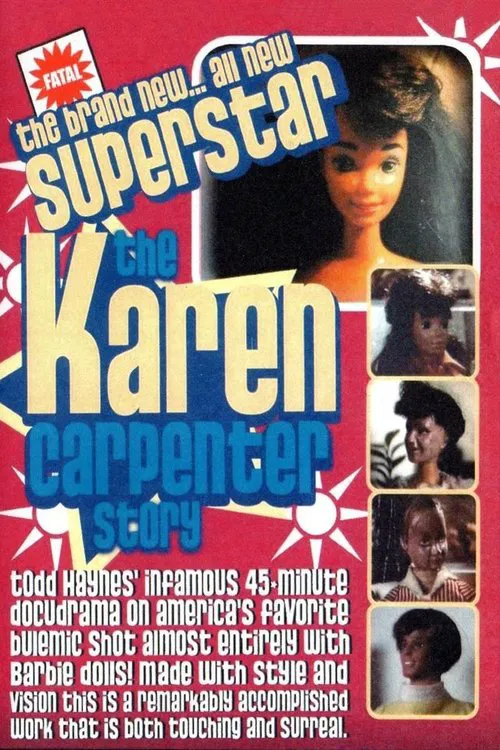Superstar: The Karen Carpenter Story

Plot
Superstar: The Karen Carpenter Story is a 1988 American experimental drama film directed by Todd Haynes. The film is notable for its unique approach to portraying the life and struggles of American singer and musician Karen Carpenter of the 1970s' music duo The Carpenters. Set apart by its distinct narrative style, the entire story is told through modified Barbie dolls created by Haynes and artist and artist-in-residence at the Museum of Modern Art in New York, Lisa Craig, which gives the audience an otherworldly and stylized feel to the film. The film is presented in a non-traditional manner as the dolls are used in tableaux settings to recreate various scenes from Carpenter's life. There are no animated sequences, voiceovers, or music playing in the manner you would typically find in other biographies or films focusing on famous musicians. The only sounds to be heard in the film come from the dolls' body parts, as when a doll is manipulated to drink from a cup, you can hear the sound of the plastic cup hitting the doll's hands as she moves her hands. The first scene we are introduced to a collection of dolls, which we are told are to tell the story of Karen Carpenter's later years. As the movie begins to unfold, we learn about the tragic and devastating struggles Carpenter encountered, both in her professional and personal life. Through a series of still-life tableaux, the film depicts the intricate and complicated dance of relationships and emotions during Carpenter's life. As we delve into the life of Karen Carpenter, the dolls depict various pivotal moments and relationships that shaped her life, from her childhood up until the time of her death. However, it is crucial to note that the narrative does not unfold chronologically but instead takes viewers through key moments and themes in Carpenter's life, often in abstract and poetic sequences. Karen Carpenter was a gifted singer, and she was a major talent for the pop genre during the 1960s and 1970s. She and her brother Richard Carpenter formed a duo that enjoyed immense commercial success with their soft pop and jazz-influenced songs. However, what is depicted through the dolls in the film is the internal struggle and battle that Karen faced in an industry heavily focused on physical appearance and beauty. The film masterfully shows the contrast between the beauty on the surface and the darkness beneath. At the same time it depicts the societal pressure she faced to conform to societal standards of beauty, a situation that significantly added to her struggles with an eating disorder. One striking scene from the film is when the dolls portray the tragic and sad story of Karen Carpenter's last night as seen at the beginning of the film, as when we see Karen drinking water with help. This particular scene stands out, and viewers can sense the fragility and vulnerability in the way the doll's body is posed. The film is a poignant tribute to Carpenter's resilience, even in the face of unimaginable hardship. With every moment depicted through the dolls, we are given a glimpse into a reality of a person and their inner turmoil often left out of many biographical narratives. It highlights how societal pressures can have the power to consume an individual's life in ways both profound and devastating. Despite not following the conventional storytelling style, Superstar: The Karen Carpenter Story provides an in-depth account of Karen's later years in her own words but through the medium of artistry, and serves as a powerful tribute to her enduring spirit.
Reviews
Recommendations



